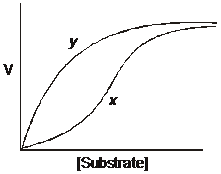The Glucose transpoter protein present in the
baso-lateral surface of the intestinal epithelial
cells is:
1. GLUT 1
2. GLUT 2
3. GLUT 3
4. GLUT 4
baso-lateral surface of the intestinal epithelial
cells is:
1. GLUT 1
The plot represents the relationship between
substrate concentration and velocity for a
single enzyme in the absence (curve x) and
presence (curve y) of a compound that binds
allosterically to the enzyme. The allosteric
compound is:

1. a competitive inhibitor.
2. a noncompetitive inhibitor.
3. an irreversible inhibitor.
4. an activator.
The metal ion that acts as a co-factor for both alcohol dehydrogenase and carbonic anhydrase is:
| 1. | Magnesium | 2. | Iron |
| 3. | Zinc | 4. | Nickel |

To unlock all the explanations of 38 chapters you need to be enrolled in MasterClass Course.

To unlock all the explanations of 38 chapters you need to be enrolled in MasterClass Course.
The living state can be best described as a:
1. non equilibrium steady state
2. non equilibrium non steady state
3. equilibrium non steady state
4. equilibrium steady state

To unlock all the explanations of 38 chapters you need to be enrolled in MasterClass Course.

To unlock all the explanations of 38 chapters you need to be enrolled in MasterClass Course.
The blood concentration of glucose in a normal healthy individual is:
| 1. 3.5 – 4.0 mM | 2. 4.0 – 4.5 mM |
| 3. 4.2 – 6.1 mM | 4. 5.0 – 5.5 mM |

To unlock all the explanations of 38 chapters you need to be enrolled in MasterClass Course.

To unlock all the explanations of 38 chapters you need to be enrolled in MasterClass Course.
All the following assumptions apply to Michaelis-Menten kinetic analyses of enzyme action EXCEPT:
1. the total enzyme concentration studied at each substrate concentration is fixed in analysis of enzyme kinetics.
2. formation of enzyme-substrate complex does not appreciably decrease the concentration of substrate.
3. Km decreases with competitive inhibition.
4. maximal velocity is reached when the enzyme-substrate complex is equal to the total concentration of enzyme present.

To unlock all the explanations of 38 chapters you need to be enrolled in MasterClass Course.

To unlock all the explanations of 38 chapters you need to be enrolled in MasterClass Course.
The conversion of glucose into lactic acid in
our muscles takes place in:
1. 9 metabolic steps
2. 10 metabolic steps
3. 11 metabolic steps
4. 12 metabolic steps
The living state is synonymous with:
1. Cellular organization
2. Metabolism
3. Consciousness
4. Reproduction

To unlock all the explanations of 38 chapters you need to be enrolled in MasterClass Course.

To unlock all the explanations of 38 chapters you need to be enrolled in MasterClass Course.
Consider the following two statements regarding enzyme action:
| I: | Co-factors play a crucial role in the catalytic activity of the enzyme. |
| II: | Catalytic activity is reduced when the co-factor is removed from the enzyme. |
Of the above statements:
1. Both I and II are correct and II explains I
2. Both I and II are correct but II does not explain I
3. I is correct but II is incorrect
4. I is incorrect but II is correct

To unlock all the explanations of 38 chapters you need to be enrolled in MasterClass Course.

To unlock all the explanations of 38 chapters you need to be enrolled in MasterClass Course.
Enzymes, vitamins and hormones are common in :
1. Being proteinaceous
2. Being synthesized in the body of organisms
3. Enhancing oxidative metabolism
4. Regulating metabolism






